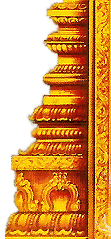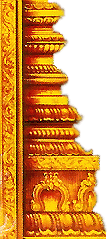The history of the temple begins from Mount Kailash with a mango fruit brought by Maharshi Narada. Child Muruga left His parents and came to this place as He could not get the mango for not fulfilling the condition to get the fruit. Lord Shiva followed Him. Lord Muruga halted at this place. Mother Parvathi did Her best for a compromise. But the Son was unrelenting and expressed His desire to stay here itself. A temple came into being for Kuzhandai Velayuthar as He was a child (kuzhandhai) then.
Great woman Tamil poet Avvaiyar, known not only for her poetic excellence but also for wisdom, called Muruga Pazham Nee and the place came to be known as Pazhani. Pazham in Tamil means fruit and also ripe knowledge.
Idumban was carrying two hills, Shivagiri and Shakti Giri to Pothigai as commanded by Sage Agasthya. Shivagiri has Lord Shiva attributes and Shaktigiri has that of Mother Parvathi. Idumban placed these mounts down here as he could not bear the weight. Lord Muruga stood on Shaktigiri and refused to come down despite Idumban’s repated demands. When Idumban decided to fight against the Lord, He showered His grace on him and kept with Him. As Muruga was holding a Danda-staff, the Lord came to be known as Dandayuthapani. Siddha Bogar who was here, made an idol of Navapashana (nine herbals) and installed in the temple. He became the presiding deity of the hill temple and became popular among the devotees.
Dandam also means a cane a tool for punishment. Lord Muruga graces here as a teacher explaining the uncertainties of life. As a teacher, He holds the Danda to correct erring pupils. In His ascetic form, Lord Muruga also teach people to shed the natural evils of greed, lust etc. in their mind and be free from passions leading to misery.
Siddha Bogar, living here than was treating people with herbals. He was assisted by his disciple Pulipani. All devotees are indebted to Bogar for gifting us Lord Himself. His monument is within the temple.
The parrot on the Danda of Lord Muruga has a fascinating religious story. All of us know there is parrot in the hands of Mother Meenakshi. There was a wicket poet Sambandandan jealous of saint poet Arunagiriar and thought of a revenge plan to eliminate him. He used his influence on King Prapuda Deva Raya requesting him to ask the saint poet to get the Parijatha flower from heaven to prove his supremacy. Arunagiriar flew into the sky in a parrot form leaving his human form in the Tiruvannamalai tower. This is an exercise called Koodu Vittu Koodu Paithal – leaving the original body form in a safe place and enter into the body of another – for noble purposes. After completing the mission, the performer leaves the adopted body and re-enter into his own.
When Arunagiriar left with his parrot body in search of the Parijatha flower, wicked Sambandandan found the human body of the saint and cremated it so that Arunagiriar cannot re-enter into his original body and appear in his human form and be his competitor. When Arunagiriar was shocked to see his body burnt, Lord Muruga blessed him by having his parrot form in His staff.
Reverting to the Idumban story:
When Idumban challenged Muruga when He refused to come down from the Shaktigiri hill, Lord Vinayaka, elder brother of Lord Muruga came to the rescue of his younger brother. Yet, He had a doubt. Vinayaka won the Mango race which hurt Muruga and may still harbour that anger against him. So Lord Vinayaka took the form of a serpent and began to fight with Idumban. This Vinayaka is on the hill path near Idumban shrine with His leg on a serpent. He is praised as Pada Vinayaka. Padam means foot. Before proceeding on the hill, the devotee should worship Vinayaka here. The footprints of Lord Muruga also are behind Vinayaka.
Tiru Aavinan Kudi is the third army camp (Padaiveedu) of Lord Muruga where He reached after His misunderstanding with parents. As He was a child then, Valli and Deivanai are not with Him here. As Muruga has all Shiva attributes, there are shrines for Lord Dakshinamurthy, Chandikeswara and Bhairava on the prakara walls of the sanctum sanctorum.
According to tradition, worship of Lord Dandayuthapani in the hill temple should begin from the Peria Avudayar 4 km from this place, Mother Perianayaki and Kuzhandhai Velayuthar shrines are also here.
The name Tiru Aavinankudi is linked with Mahalakshmi (Tiru), Gomatha the cow (Aa), Inan (Sun), Ku (earth) di (fire the Agni) who worshipped Kuzhandhai Velayuthar here. Their idols are in the inner corridor – prakara of the temple.
Lord Muruga also granted a Japa Mala to saint Arunagiriar when he sang the Lord’s praise. The saint has mentioned this in his songs.
Brahmma Theertha is on the north of Palani. On its bank, Lord Shiva with Mother Parvathi, Lord Vishnu on His Garuda vehicle and Lord Brahmma on His Swan vehicle appear and grace the devotees. All three Lords are facing west which has its special significance religiously. Worshipping them together ensures total relief from sins, it is believed.
There is a spring on the hill path called Valli Chunai where Muruga graces devotees with Valli in wedding form. Women devotees pray here with the yellow thread (mangal Sutra). Mother Valli also graces sitting alone under the Vilwa tree nearby. Abishek is performed to Nagar (serpent deity) in the Valli Chunai.
Lord Muruga graces His devotees in three forms. 1) The Lord grants darshan in a wedding form with Valli and Deivanai without the peacock vehicle in Periyanayaki temple, 2) as a child on the peacock in Tiru Aavinan Kudi temple and 3) with His Danda-staff in the hill temple. It is indeed a very rare fortune for the devotees to worship the Lord in three forms in a single place.
While Aipasi Annabishekam is performed to Lord Shiva only in temples, it is performed to Lord Muruga in Palani. This is done on the Jeshta star day in the month of Aani at the midday pujas in the hill temple and on the Moola star day in the same month at the Tiru Aavinankudi Kuzhanthai Velayuthar temple during the evening pujas. The Annabishekam is performed to Lord Shiva on the Uthrada star day in the Periyavudayar temple.
Idumba, belonging to the earlier story of carrying two hills to Pothigai, has his shrine on the hill route. Abishek to Idumban is performed at 3.00 a.m. followed by Puja at 5.00 p.m. Pujas to Muruga follows in the hill temple only afterwards. There is a shrine to Idumba on the hill path, appearing with the two hills on his shoulders. There is also a Nandhi before the shrine with his foot prints and of Kadamban.
As Guru, sage Agasthya is in the shrine with Idumba and Kadamba on his side. As the sage also is in the shrine, water Prasad is offered to the devotees from his kamandala, a bowl with a handle used by the Rishis. It is believed that Agasthya himself is offering the Prasad himself that contains rich medicinal properties. |





